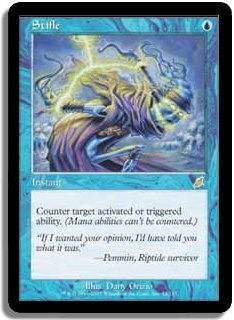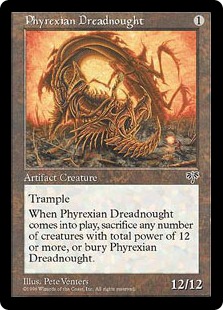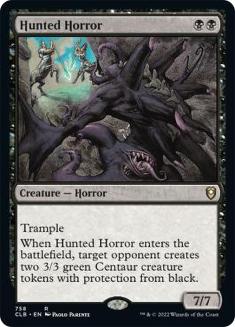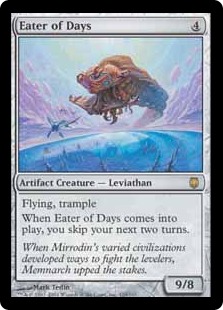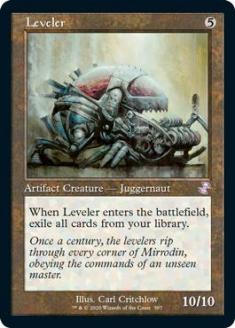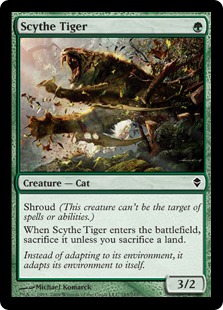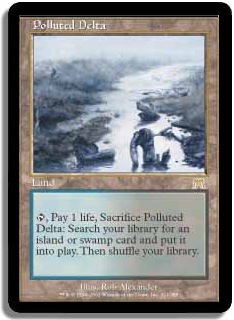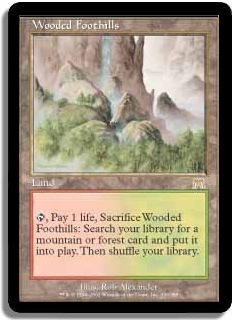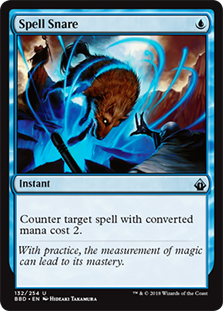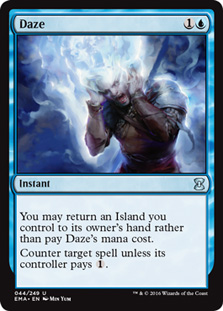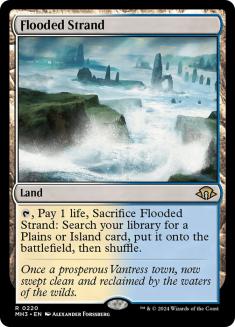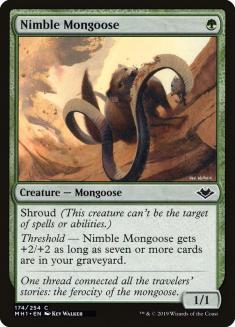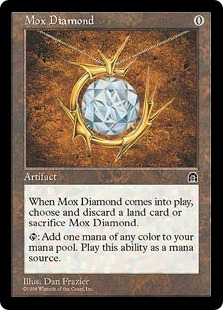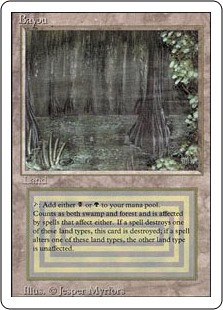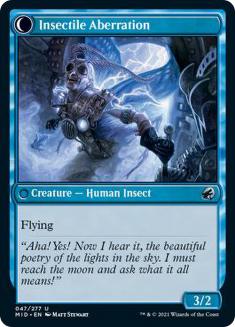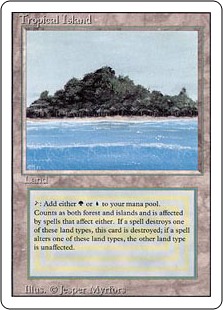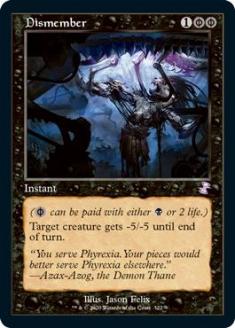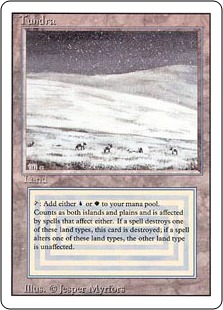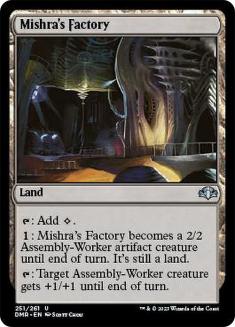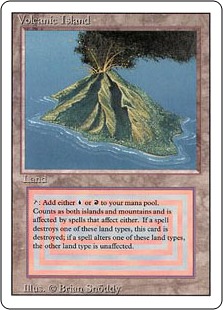I’ve been known to Stifle more than a few fetchlands while playing Legacy. But Stifle is one of the most polarized cards in Legacy. In an opening hand, the card is incredibly powerful. A late-game Stifle off the top of the deck is worse than a dead card.
I’m going to apologize in advance if things start off too basic for some readers. “Counter target activated or triggered ability. (Mana abilities can’t be targeted.)” What is an activated ability, what is a triggered ability, and what are mana abilities? While some of you may gloss over this section, it is important to know what your cards do, so as to not miss an interaction that can cost you a game.
Activated Ability
Triggered Ability
Mana Ability
605.1b. A triggered ability without a target that triggers from activating a mana ability and could put mana into a player’s mana pool when it resolves is a mana ability.
These definitions come from the Sept. 30, 2011 update to the comprehensive rules.
Quiz time
Stoneforge Mystic has a triggered ability, “When Stoneforge Mystic enters the battlefield, you may search your library for an Equipment card, reveal it, put it into your hand, then shuffle your library.” It can be stifled.
“Koth of the Hammer has an activated ability, “-2: Add R to your mana pool for each Mountain you control.” It is not a mana ability, since it is a loyalty ability. It can be stifled.”
Polluted Delta has an activated ability, “Tap, Pay 1 life, Sacrifice Polluted Delta: Search your library for an Island or Swamp card and put it onto the battlefield. Then shuffle your library.” It can be stifled.
Dryad Arbor has a single activated ability, “Tap: Add G to your mana pool.” However, it is a mana ability, since it is an activated ability that produces mana. It cannot be Stifled.
Carpet of Flowers has a single triggered ability, “At the beginning of each of your main phases, if you haven’t added mana to your mana pool with this ability this turn, you may add up to X mana of any one color to your mana pool, where X is the number of Islands target opponent controls.” This triggered ability can add mana to your mana pool when it resolves. However, the ability has a target, an opposing player. Also, it is not triggered from another mana ability. This means Carpet of Flowers can be Stifled.
Wild Growth has a single triggered ability, “Whenever enchanted land is tapped for mana, its controller adds G to his or her mana pool.” It triggers from another mana ability, tapping the enchanted land for mana. It cannot be Stifled.
Lotus Cobra has a single triggered ability, “Whenever a land enters the battlefield under your control, you may add one mana of any color to your mana pool.” Similar to Carpet of Flowers, Lotus Cobra’s ability is a triggered ability that can generate mana. However, it is not triggered from a mana ability. Lotus Cobra can be Stifled.
Rift Bolt has two triggered abilities while suspended, “At the beginning of your upkeep, remove a time counter. When the last is removed, cast it without paying its mana cost.” Both of these are triggered abilities and can be stifled. The importance of this example, however is that there are two triggered abilities involved with suspend. One functions when there is a counter on Rift Bolt, and it removes a counter. The second ability lets Rift Bolt be cast when the last time counter is removed.
Now that we have a better idea of what Stifle can do for you, let’s discuss the theory of why we even play Stifle in the first place.
There are three main reasons to play Stifle. To delay an opponent’s game plan, to advance your own game plan, and to preserve your manabase.
Manabase Preservation
Let’s look at these cases in reverse order. The most straightforward use of Stifle is as a means of proactively countering opposing Wastelands and Ghost Quarters. Especially against inexperienced players that will fire off a Wasteland at their first opportunity, Stifle generates a similar amount of tempo compared to Stifling their fetchland, but preserves the typical fragile manabases Stifle-based decks run.
Advancing your Game Plan
The second situation, advancing your own game plan, comes up in a handful of situations as well. Wizards of the Coast likes to print large creatures with triggered ability drawbacks.
Stifle pairs up with all of these cards to unleash powerful creatures at the low cost of a second mana. To be fair, Phyrexian Dreadnought is the only one of these creatures that sees even some regular play, but the combo is a powerful one that has been played for years in Legacy.
Stifle can target a handful of other abilities controlled by you as well. Cumulative Upkeep is a personal favorite… just as an opponent thinks their Knight of the Reliquary will be losing a Mind Harness, Stifle keeps it shackled for yet another turn. (The Cumulative Upkeep counter is still added to Mind Harness)
Don’t underestimate countering your own Dark Confidant’s triggered ability. I’ve seen it win more than a few games, where an errant Force of Will would otherwise end it.
Delaying an Opponent’s Game Plan
There are two ways Stifle can complicate an opponent’s game plan. Countering their fetchlands and countering various activated and triggered abilities, such as Batterskull’s Living Weapon ability.
While many players are familiar with the concept of card advantage, and by extension trading cards for life, life for cards, and other measures of exchange, one that is harder to understand is trading cards for time. Stifle’s main purpose is to trade cards in your hand for time; one more attack step before an opponent plays Knight of the Reliquary, one more turn before Jace starts sealing your fate. However, this is all Stifle does; delay the inevitable. At some point in time, whatever Stifle had prevented is going to happen. Therefore, all Stifle decisions need to be made with this concept in mind. Will this Stifle put me in position to win the game, or is there a better situation for it to be played?
The most important part of Stifling fetchlands is to Stifle with a purpose. Their fifth land isn’t as important as their fourth, or their first. The value of Stifle at any point in the game is constantly shifting. This concept is far easier to illustrate with examples. Bear in mind these situations are all rather subjective. There is no clear-cut right and wrong decision on any of them.
Both players kept their starting seven. You are on the play. Your deck is this one.
Creatures (11)
Lands (17)
Spells (32)

Their hand: 7 cards
Their battlefield:
Your battlefield:
Your hand:
There is a little outside information we can infer by their line of play. Polluted Delta is playable in a broad range of decks, but these tend to be combo and aggro-control decks. Most likely, our opponent is playing a combo deck, as an aggro-control deck would rather hold fetchlands in play and not make the first move.
Combo decks are typically mana-light, so destroying their first land is probably the right course of action. If they are actually a combo deck, this Stifle will make them take longer to set up. Stifle is a weak card against most combo decks as well, even storm-based ones. Most good Storm players will use Duress and Thoughtseize to strip Stifle from our hand.
We can’t evaluate Stifle in a vacuum, so let’s look at the rest of our hand. With Daze in our hand, the value of Stifle as mana disruption is far higher, as we want Daze to actually counter something this game. More importantly, we have a threat, Nimble Mongoose. It is very important for a threshold deck to put a threat on the table and force their opponent to respond.
Wooded Foothills should find a Tropical Island in this situation because it creates stronger lines of play on subsequent turns; Flooded Strand, Nimble Mongoose, pass with a Brainstorm on the following turn.
This is a relatively easy example, but the key points are this:
- Our opponent is playing a deck with few effective Stifle targets
- We will have a threat on the board the following turn
- We need to keep Daze live as the game goes longer
Example 2: Turn 4, we were on the play. It is their turn.
Their hand: 3 cards
Their battlefield:
Your battlefield:
Your hand:
Our Graveyard:
Daze
Spell Snare
Force of Will
Their Graveyard:
Tarmogoyf
Hymn to Tourach
Thoughtseize
Maze of Ith
Our opponent has missed his land drop the turn prior, and on this turn played a Windswept Heath, presumably off the top of his deck and activates it.
Our opponent is playing some variant of Junk / Rock, this much is clear. So we need to get some information on the deck itself. Some variants play Stoneforge Mystic, and others don’t.
Case 1:
If our opponent is playing Stoneforge Mystic, then there is no reason to Stifle this land; we can simply wait for them to play a Stoneforge Mystic, which can be Stifled instead.
Stoneforge Mystic is a much bigger threat situationally. However, our opponent has had two mana, and we have already played a Daze this game. If they had Stoneforge Mystic, they would have already played it. Our hand has both Lightning Bolt and Dismember, which means we can answer Batterskull or Sword of Feast and Famine as well, downplaying the effectiveness of Stoneforge Mystic in this situation.
Case 2:
If our opponent is not playing Stoneforge Mystic, then we should Stifle this land. In most Junk decks, there are only a handful of targets for Stifle; almost entirely their manabase. Therefore, we should just jam the Stifle, right?
Not entirely; we are playing Brainstorm, which gives us the opportunity to filter Stifle away for other, better cards. Also, we can wait for a Wasteland to Stifle, if we wanted to.
In this matchup, we need to keep out Junk playing opponent off of three lands, as many of their game-breaking spells are at three mana. Even something as simple as a Vindicate can make this game difficult, as we are on only one threat, with no more in our hand.
If our opponent doesn’t have Vindicate, instead only Knight of the Reliquary, then we have a Dismember to answer it. However, this is a major gamble; our opponent has three cards, and plenty of ways to get rid of our threat.
In either situation, I would go ahead and Stifle this land. Insectile Aberration only needs five turns to work its magic, and this well-timed Stifle can do just that.
Example 3:
Their hand: 2 cards
Their life total: 8
Their battlefield:
Your battlefield:
Your hand:
Your life total: 18
Your graveyard: 8 cards
Grim Lavamancer is not summoning sick.
Your opponent casts a Stoneforge Mystic.
What is Stoneforge Mystic going to be doing? There are three real cards it can find in most typical U/W decks: Batterskull, Sword of Feast and Famine, or Umezawa’s Jitte. Of these, Sword of Feast and Famine is far too slow to be effective, as you have already been run out of cards. Umezawa’s Jitte needs to stick to a creature, something that is unlikely with an active Grim Lavamancer. No, the real threat here is Batterskull.
How is this game going to end? It should be relatively clear. Our Grim Lavamancer will deal them enough damage to win, or they will connect with a Batterskull and win the game. Our goal, then, is to stop a Batterskull from coming online. Therefore Stifle MUST be used in whatever manner we can to stop Batterskull from becoming relevant. We have already ceded that we are dead to a removal spell.
Now we can turn to the decision at hand, to Stifle the Stoneforge Mystic’s trigger or not. The intuitive play is to Stifle the Stoneforge Mystic’s enter the battlefield trigger, leaving them with only a Squire. But is it only a Squire? No. It still has the ability to sneak equipment into play.
Case 1: Our opponent has Batterskull in hand
If we Stifle the Stoneforge Mystic trigger, we can shoot them for two with Grim Lavamancer, taking them down to six. We pass, they pass, and we shoot them for two more, down to four. We pass, and they can activate Stoneforge Mystic on our end step. Batterskull enters the battlefield; they untap and attack to gain four life. We have lost this game.
If we choose not to Stifle the Stoneforge Mystic trigger, the game gets to the same point in time as when they are at four life, and activate Stoneforge Mystic. At this point, we can Stifle the Living Weapon trigger, leaving them with an empty Batterskull. At this point, they can bounce and replay Batterskull on their turn, but we can burn them for two on their end step and two more on our main phase, to win the game.
Case 2: Our opponent does not have Batterskull in hand
This is the same as the above case, except we win the game regardless.
Beating the Stifle decks
Stifle is most devastating against opposing decks when it stops them from playing Magic, keeping them off the number of lands they want to have in play. Not reaching your third or fourth land drop on time can be devastating for many decks. The bottom line, with Stifle? If you don’t want to lose games by getting your lands Stifled, PLAY MORE OF THEM. Absent additional lands, there are other alternatives.
Northeast Legacy grinder Geoff Smelski introduced me to a unique solution to beating Stifle decks (as he was beating me playing for top 8).
Creatures (14)
Lands (19)
Spells (27)
- 4 Brainstorm
- 4 Lightning Bolt
- 2 Force of Will
- 4 Natural Order
- 3 Daze
- 2 Ponder
- 4 Green Sun's Zenith
- 4 Mental Misstep
Sideboard

Stifle and Wasteland are huge problems for NO RUG; the deck only has 19 real lands and a handful of mana birds, while trying to resolve four mana sorceries. Give the decklist a look, and see if you can figure out what his plan is.
Geoff sideboards up to a full four Ponders on top of the four Brainstorms he is already playing. Although two more Ponders don’t seem like much, the increased library manipulation gives his deck more ways of interacting early in a match. Ponder is stronger than Preordain against Stifle, as it lets you have four chances at hitting a land, instead of three.
If Stifle isn’t turned towards manabases, it is far less effective. While turning a Stoneforge Mystic into a Squire is a strong play, it shouldn’t be a real concern for someone playing against Stifle; they traded two mana and a card for one mana, a card and a 1/2.
Stifle decks represent a unique challenge to Magic players everywhere. Learning when or when not to play Stifle is the difference between winning and losing games.

